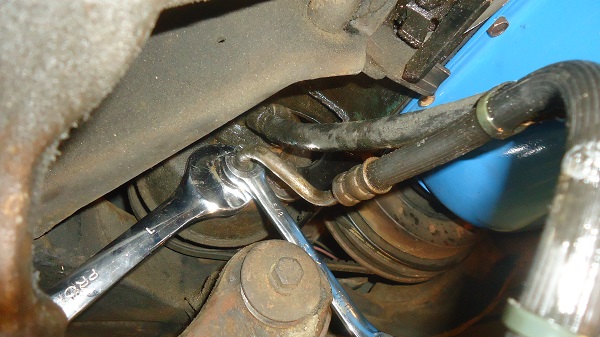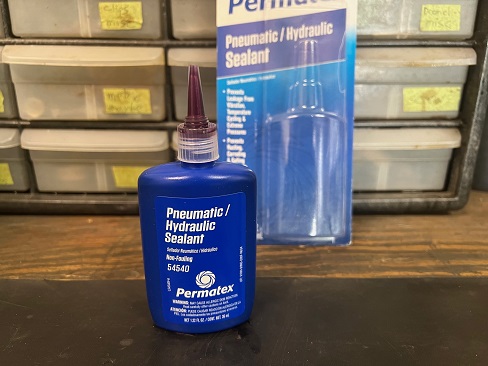Replace Power Steering Hoses on C2 C3 Corvette
Article and Pictures by Mark Trotta
Simply from age, power steering hoses will harden, crack and leak, and need replacing. C2 and C3 Corvettes have four of them, and it's best to replace them together.

After rebuilding the power steering cylinder and replacing the control valve on my 1982 Corvette, new power steering hoses were installed. Procedures for 1963-1982 Corvettes are virtually the same.
C2 C3 Corvette Power Steering Hoses
The low pressure hose is the same from 1963 through 1982. The high pressure hose is the same from 1963 to 1979, and 1980-1982 pressure hoses are the same.

The low pressure side uses a hose clamp on the steering pump and a pressure fitting on the cylinder. The high pressure side has a pressure fitting on both ends.
In 1980, the discharge fitting on the P/S pump was changed to metric thread, to 16x1.5mm (18mm wrench size) and uses an o-ring seal.
The two hoses that run from the control valve to the steering cylinder (extend and retract hoses) are all the same from 1963 to 1982.
Tools Needed
To prevent stripped nuts, use flare nut wrenches to loosen and tighten the ends. An open end wrench will come in handy to speed up the process in between loosening and tightening.
Get The Car Off The Ground
Prop up the car on four jack stands and remove the driver's side front tire. I removed my front right tire as well, since I was going to be doing other work as well.

Removing Old Power Steering Hoses
Replacing power steering hoses is a messy job!
Place a drip tray or an old kitchen cooking pan under the pump and surrounding area.
It's a good idea to keep a car cover on the car (or a few old towels) in case any fluid gets on the paint.

Unless you like busted knuckles, wear work gloves to protect your hands while you are breaking free the fittings. Safety glasses are also recommended.
Disconnect the two hoses from the control valve, letting the fluid drain out into a tray or container. Remove the hoses.
To remove the pressure hose from the steering pump, I used a 1" wrench on the large nut, then a 5/8" flare-nut wrench on the fitting. I used flare-nut wrenches to break the fittings free and then later to snug them back down.

If your pump still has the original factory clamp on it, you can remove it by clamping down on the crimp edge with a sharp pair side cutters and cutting it. There may be a hose clamp on there already, which will make removal easier.
NOTE: After you have the hoses disconnected, do not move the wheels or power steering fluid will shoot out of the ports!
Dispose of the old fluid properly. It gets recycled with used engine oil.
*********************
Replacement Corvette P/S Hoses 1963-1979
Midwest is one of the oldest suppliers for Classic Corvette parts. Their power steering hose kit fits 1963 through 1979 small-block equipped Corvettes.

For 1980-1982 steering hose kit click here.
*********************
Install New Hoses
To install the new hoses, start with P/S pump side first.
NOTE: On 1980, 1981, and 1982 Corvettes, lightly oil the O-ring with p/s fluid before installing.

There is a large O-ring that sits behind the big nut in back of the PS pump. If you want to change this, be aware that it's spring-loaded. Oil the O-ring with p/s fluid and carefully thread back in.
Next, install the pressure hose onto the control valve, then the return hose can be installed.
TIP: Start fittings by hand to ensure they're going in correctly.
Do Not Over-Tighten Fittings
Don't over-tighten the fittings or you could twist a pipe or a fitting. Also be careful with the connections to the control valve, because the casting can crack.

The extend and retract hoses to the steering cylinder can be tricky to install, since they are slightly angled. Do not use a wrench to tighten these until you start them by hand.
After the new hoses are installed and tightened, wipe down any drips and look for leaks. Remove the drain pan and put some old cardboard under the car as a precaution for any residual drips.
Fill the P/S pump with quality power steering fluid.
Getting to the pump was awkward on my '82, its sort of "hidden" under the alternator. I used a long flexible hose with a funnel.

Check pump fluid level and add as required, but it shouldn't need very much. It is not necessary to completely eliminate all of the 40 year-old fluid (or who knows what was used to replenish through the years.) But the more genuine fluid you add, the better.
Power Steering Fluid vs ATF Fluid
Automatic transmission fluid (ATF) is similar to, but not identical to power steering fluid. While some manufacturers recommend ATF for their vehicles, GM specifically recommends P/S fluid for the Corvette (see owner's manual). ATF would work, but it's not the best fluid to use.

GM approved power steering fluid contains additives designed to help the pump perform optimally as well as to prevent seals from leaking.

After the pump is full, crank the engine and let it run for 30 seconds or so, then shut it off. After the engine is running the fluid level drops.
Check and top off the fluid level. Repeat until the fluid level no longer drops. If the fluid starts out foamy, don't be alarmed. It will work itself out as air is released from the system.
Do I Need To Bleed The Steering System?
Your Corvette's power steering system is self-bleeding, as the return line constantly brings fluid back into the reservoir. However, if you'd like, you can manually bleed the system. Turn the steering wheel at least three full turns lock-to-lock to purge the air out of the system. If you see air bubbles in the reservoir, let the car sit a couple hours and check the level again.
*********************
Best Hydraulic Sealant
If you're getting small fluid leaks, or slight weeping from the fittings, Permatex 54540 Hydraulic Sealant seals any metal thread, and will not contaminate power steering fluid.

*********************
Take A Short Test Drive
While driving slowly, move the steering wheel all the way to the left, then all the way to the right several times. Double-check for leaks afterwards.

*********************
Related Articles
Restore An Old Corvette
C3 Corvette Exhaust
Corvette Crossfire Maintenance and Diagnosis
Rebuild Corvette Calipers
Rebuild Corvette Calipers (Reassembly)
Lip Seal vs O-Ring Calipers
Removing Riveted Brake Rotors
